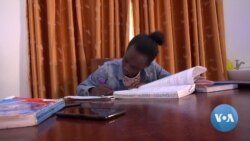A Kenyan man who was born deaf has developed a mobile learning application for sign language to help deaf children learn online during the COVID-19 pandemic.
For 13-year-old deaf student Stephanie Njeri, remote learning during the COVID-19 pandemic could have been quite difficult. But thanks to the Kenya Sign Language Finger Spelling application, she has been able to keep up with her studies.
"It is easy for me when I am doing my homework and revision on my own, when my parent(s) forget to finger spell it helps to remind them," she said through a sign language translator.
Njeri's father, Robert Mathari, helps her study, and the KSL Finger Spelling app helps them communicate.
"During homework sessions you'll find that there are things she want me to assist," he said. "But if she tries to sign to me, I'm not able to comprehend exactly what she needs. So, she shall open the app and she'll start showing me — this is what I want.''
The application was developed during the pandemic by Hudson Asiema, who was born deaf, to help Kenya's 4,000 deaf schoolchildren with remote learning.
"We don't have a lot of these apps that are centered for children accessible offline," he said through a sign language translator. "When you compare the same with the hearing kids now, they have a lot of apps that they can access for them to learn easy basics of language, like alphabets.''
Disability organization inABLE helped Asiema develop the app, says program manager Peter Okeyo.
"Why iNABLE is coming in, is to help develop this app or help link up the designer or developer with specialists from across the world so that the app is enabled to have more features to be more friendly, even to the younger ones," Okeyo said.
Deaf community leaders in Kenya say the technology has improved learning among deaf students.
Chairman of Kenya's National Association for the Deaf, Nixon Kakiri, said through a sign language translator: "It will sort out the issue of children staying at home and not learning sign language and through this app ... it's something which is very technical because they'll have to use their phone and it will be very helpful to the deaf."
While the app was designed for deaf students learning at home, students have found it useful even after they returned to school earlier this month.








